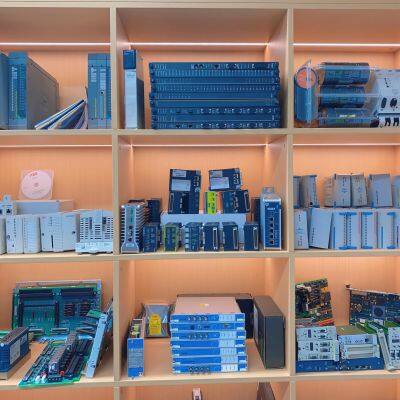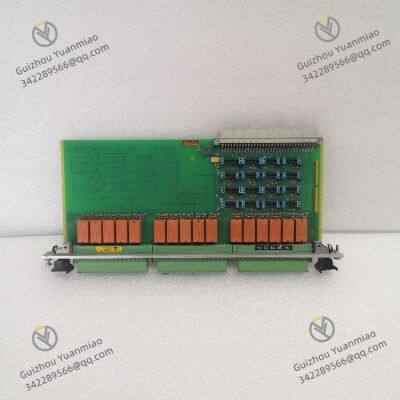Product Description
Vibro-Meter 200-570-000-014 200-570-101-013 VM600 is a high-performance monitoring module, specially designed for high-precision condition monitoring and control of industrial equipment. With advanced monitoring technology, powerful data processing capability and wide compatibility, it plays an important role in key links of industrial production, provides comprehensive guarantee for the safe and stable operation of equipment, and helps enterprises realize intelligent operation and maintenance as well as efficient production.

I. Core Functions
(1) High-precision Multi-parameter Monitoring
Diversified parameter collection: The module is equipped with abundant acquisition channels, which can simultaneously monitor various key parameters of equipment such as vibration, rotating speed, temperature and pressure in real time. In the monitoring of large centrifugal compressors, it can synchronously collect parameters such as vibration acceleration of each bearing, shaft vibration displacement, rotor speed, lubricating oil temperature and inlet and outlet pressure of the compressor, comprehensively reflecting the operating status of the equipment and providing multi-dimensional data support for the health assessment of the equipment.
High-resolution data acquisition: It adopts a high-precision A/D converter with a data acquisition resolution of up to 16 bits, which can accurately capture subtle parameter changes during equipment operation. For example, in the monitoring of precision machine tools, it can accurately sense small amplitude changes of spindle vibration, timely detect abnormalities caused by tool wear or spindle imbalance, and ensure that the machining accuracy is not affected.
Wide range of signal adaptation: It supports input of various signal types, including charge signals and voltage signals of vibration sensors, pulse signals of speed sensors, and thermocouple and thermal resistance signals of temperature sensors, etc., and can be adapted to different types of sensors, improving the versatility and application range of the module. In the monitoring of rolling mills in steel plants, it can simultaneously connect vibration sensors, speed encoders and temperature sensors to realize comprehensive monitoring of the operating status of rolling mills.
(2) Intelligent Data Analysis and Diagnosis
Real-time data processing: The module has a built-in high-performance processor with strong real-time data processing capability. It can quickly analyze the collected raw data, calculate characteristic parameters such as peak-to-peak value, effective value and kurtosis of vibration, and judge in real time whether the equipment is in normal operating status. In the monitoring of turbo-generator sets, it can real-time analyze the spectral characteristics of vibration signals and timely identify fault features such as rotor unbalance and misalignment.
Fault pattern recognition: Through the built-in fault diagnosis algorithm, it can identify a variety of common equipment fault patterns, such as bearing wear, poor gear meshing, rotor cracks, etc. When an abnormality is detected in the equipment, it can automatically analyze the fault type and issue corresponding diagnostic information, providing maintenance personnel with a clear direction for fault troubleshooting. For example, in the monitoring of fans, if the module identifies the characteristic frequency of bearing faults, it will promptly prompt maintenance personnel to inspect and replace the bearings.
Trend analysis and prediction: It has long-term data storage and trend analysis functions, which can record the historical change trend of equipment parameters, and predict the development trend of equipment faults and remaining service life through trend prediction algorithms. In the monitoring of water pump units, through long-term trend analysis of vibration amplitude and temperature, the aging degree of bearings can be predicted in advance, providing a scientific basis for formulating preventive maintenance plans.

(3) Flexible Alarm and Control
Multi-level alarm setting: It supports multi-level alarm threshold setting. Different alarm levels, such as prompt alarm, warning alarm and danger alarm, can be set according to the importance of the equipment and the scope of fault impact. Different alarm levels correspond to different response measures. Prompt alarms are only displayed locally, warning alarms can be uploaded to the control system through the communication interface, and danger alarms can directly trigger equipment shutdown to ensure equipment safety. In the monitoring of chemical reaction kettles, when the pressure exceeds the danger threshold, the module can immediately trigger a shutdown alarm to avoid safety accidents.
Diversified alarm output modes: It has various alarm output modes such as relay output, analog output and digital output, and can select the appropriate output mode to link with external equipment according to actual needs. For example, when the module issues a warning alarm, it can control the sound and light alarm to give an alarm through the relay output to remind on-site operators; at the same time, the alarm information can be uploaded to the central control system through digital output for remote monitoring.
Remote control function: It supports remote control through the communication network. Operators can set parameters of the module, adjust alarm thresholds, and control the remote start and stop of equipment in the remote monitoring center. In distributed industrial sites, the remote control function can reduce on-site operations, improve operation and maintenance efficiency, and reduce labor costs.
(4) Efficient Communication and Integration
Support for multiple communication protocols: It supports multiple mainstream industrial communication protocols such as Ethernet/IP, Modbus TCP and Profinet, and can be seamlessly integrated with control systems such as PLC, DCS and SCADA to realize real-time data interaction and sharing. In the construction of smart factories, the module can upload monitoring data to the factory management system through industrial Ethernet, providing data support for production scheduling and equipment management.
High-speed data transmission: It adopts a high-speed communication interface with a data transmission rate of up to 100Mbps, which can ensure real-time transmission of monitoring data and meet industrial scenarios with high real-time requirements. In the monitoring of traction motors of high-speed trains, high-speed data transmission can ensure that key parameters such as vibration and temperature of the motor are transmitted to the control system in a timely manner, ensuring the safe operation of the train.
Strong system scalability: It supports multi-module cascading, and can flexibly expand the system scale according to the number and distribution of monitoring points. In the monitoring of large hydropower stations, through the cascading of multiple modules, centralized monitoring of multiple equipment such as water turbines, generators and transformers can be realized, forming a complete monitoring network.

II. Hardware Characteristics
(1) Industrial-grade Reliability Design
Wide temperature operating range: It adopts industrial-grade components and a special heat dissipation structure design, and can work stably in extreme temperature environments from -40℃ to +85℃. Whether in the monitoring of polar oilfield equipment in cold areas or in high-temperature steel smelting workshops, the module can maintain normal monitoring performance and ensure the accuracy of monitoring data.
Strong anti-interference ability: It has excellent electromagnetic compatibility, passed strict electromagnetic interference (EMI) and electromagnetic susceptibility (EMS) tests, and can work reliably in strong electromagnetic interference environments. The module adopts multiple shielding, filtering and isolation technologies internally, effectively resisting the impact of external electromagnetic interference on signal acquisition and processing. In strong electromagnetic environments such as substations, it can ensure the stability and reliability of monitoring data.
High protection level: The protection level reaches IP66, with good dustproof, waterproof and anti-corrosion performance, and can be directly installed outdoors or in harsh industrial sites. In the monitoring of port machinery, the module can resist the erosion of sea wind, moisture and dust, and run stably for a long time.
(2) Compact Structure and Flexible Installation
Miniaturized design: The module adopts a miniaturized design with small size and light weight, which is convenient for installation on equipment with limited space or in control cabinets. In scenarios where equipment space is tight, such as CNC machine tools, the miniaturized design can reduce the impact on equipment layout and improve installation flexibility.
Multiple installation methods: It supports multiple installation methods such as guide rail installation, panel installation and wall-mounted installation, and can select the appropriate installation method according to the actual installation environment. In the transformation of on-site equipment, flexible installation methods can reduce installation difficulty and shorten the installation cycle.
Modular structure: It adopts a modular design, and each functional module is independently packaged, which is convenient for maintenance and replacement. When a functional module fails, only the corresponding module needs to be replaced without disassembling the entire equipment, reducing maintenance time and cost.

(3) Stable Power Management
Wide voltage power supply: It supports 12V-36V DC wide voltage power supply, which can adapt to power voltage fluctuations in different industrial sites and improve the adaptability of the module. In industrial sites in remote areas where the power supply voltage is unstable, the module can still work normally to ensure the continuity of monitoring.
Power protection functions: It has complete power protection functions such as overvoltage protection, overcurrent protection, undervoltage protection and reverse connection protection, which can effectively protect the module from the impact of power failures. In case of wrong power wiring or abnormal voltage, the module can automatically cut off the power supply to avoid damage to the internal circuit.
Low power consumption design: It adopts low-power components and optimized circuit design, so the power consumption of the module is low, which can reduce energy consumption and operating costs. In portable monitoring equipment powered by batteries, the low-power design can extend the service life of the battery.
III. Application Fields
(1) Energy and Power Industry
Power generation equipment monitoring: It is widely used in the monitoring of power generation equipment in thermal power plants, hydropower plants, wind power plants, etc., such as steam turbines, generators, water turbines, wind turbines, etc. By monitoring parameters such as vibration, speed and temperature of the equipment, potential faults of the equipment can be found in time, the reliability and operating efficiency of power generation equipment can be improved, and downtime can be reduced. For example, in the monitoring of wind turbines, the module can real-time monitor the vibration of blades and the temperature of generators, and timely detect problems such as blade damage and generator overheating.
Transmission and distribution equipment monitoring: It is used for the monitoring of transmission and distribution equipment such as transformers, high-voltage switches and reactors. By monitoring parameters such as vibration, temperature and oil level of the equipment, the operating status of the equipment can be judged, and power grid accidents caused by equipment faults can be prevented. For example, the vibration monitoring of transformers can timely find problems such as loose iron cores and winding faults, ensuring the safe operation of transformers.

(2) Metallurgical Industry
Rolling mill equipment monitoring: In the rolling mill production line of iron and steel metallurgy, it is used to monitor parameters such as vibration, temperature and speed of key equipment of the rolling mill, such as work rolls, backup rolls and motors. Real-time grasp of the operating status of the rolling mill, timely detection of problems such as roll wear and bearing faults, to ensure the quality of rolled products and production efficiency. For example, through the monitoring of the vibration of the work rolls of the rolling mill, the rolling parameters can be adjusted in time to avoid uneven thickness of the plate caused by roll imbalance.
Smelting equipment monitoring: It is used for the monitoring of smelting equipment such as blast furnaces, converters and electric arc furnaces, monitoring parameters such as furnace body vibration, cooling water temperature and furnace pressure of the equipment, ensuring the safe and stable operation of smelting equipment, and improving smelting efficiency and product quality.
(3) Rail Transit Industry
Train traction system monitoring: It is applied to the monitoring of traction motors, traction converters and other equipment of high-speed trains, subway trains, etc., real-time monitoring parameters such as vibration, temperature, current and voltage of the equipment, timely detecting abnormal conditions of the equipment, and ensuring the safe operation of the train. For example, the vibration monitoring of traction motors can timely find problems such as motor bearing faults and rotor imbalance, avoiding train failures during operation.
Track facility monitoring: It is used for the monitoring of parameters such as vibration and displacement of the track, evaluating the stability and safety of the track, and providing a basis for track maintenance and repair. In the monitoring of high-speed rail tracks, through long-term monitoring of track vibration, track settlement and deformation can be found in time to ensure the driving safety of trains.
(4) Marine and Ocean Engineering
Ship power system monitoring: It is used for the monitoring of power equipment such as ship main engines, auxiliary engines and propellers, monitoring parameters such as vibration, speed, temperature and oil pressure of the equipment, ensuring the normal operation of the ship's power system and improving the navigation safety of the ship. In the monitoring of ocean-going freighters, the module can real-time monitor the operating status of the main engine, timely detect faults and give early warnings, avoiding power interruption during navigation.
Offshore platform equipment monitoring: It is applied to the monitoring of drilling equipment, compressors, pumps and other equipment on offshore oil platforms, ensuring the stable operation of equipment in harsh marine environments, and reducing production interruption and safety accidents caused by equipment faults.
Vibro-meter VM600?200-560-000-114?200-560-101-018?IOC4T Key Input/Output Control Module
GE WES5123-1200 Remote Terminal Unit
Vibro-meter 200-582-500-021 VM600 RPS6U SIM-330A Power Supply
Vibro-meter SIM-275A 200-582-500-013 Power Supply
VIBRO-METER VM600 RPS6U 200-582-500-013 Rack Power Supply
Vibro-meter VM600 RPS6U 200-582-200-011 Power Supply


Vibro-meter 200-595-031-111 VM600 CPUM Input/Output Communications Network Card
VIBRO-METER 200-595-100-014 200-595-072-122 VM600 CPUM CPU Board
VIBRO-METER 600-003 620-001-001-116 VM600 XMV16 Regulator Module
VIBRO-METER 620-002-000-113 620-003-111-112 VM600 XIO16T Communication Interface Card
Vibro-meter MPC4 200-510-078-115 Machinery Protection Card
Vibro-meter VM600 MPC4 200-510-064-034 200-610-100-034 Machinery Protection Card
GE IS420YDIAS1B Discrete Output I/O Pack
GE IS420YAICS1B Analog I/O Pack
GE IS420YDOAS1B Discrete Output I/O Pack
GE IS410STCIS2A Compact Contact Input Terminal Board
GE IS410STAIS2A Analog I/O Module
GE IS410SRLYS2A Simplex Terminal Board
 yezi
Hi there! Welcome to my shop. Let me know if you have any questions.
yezi
Hi there! Welcome to my shop. Let me know if you have any questions.







